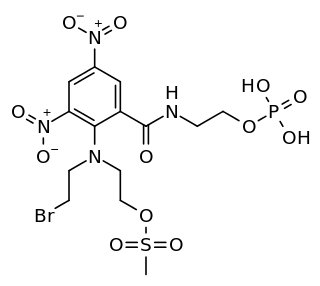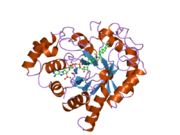
In enzymology, aldose reductase is a cytosolic NADPH-dependent oxidoreductase that catalyzes the reduction of a variety of aldehydes and carbonyls, including monosaccharides. It is primarily known for catalyzing the reduction of glucose to sorbitol, the first step in polyol pathway of glucose metabolism.

Sepiapterin reductase is an enzyme that in humans is encoded by the SPR gene.

Aldo-keto reductase family 1, member B1 (AKR1B1), also known as aldose reductase, is an enzyme that is encoded by the AKR1B1 gene in humans. It is a reduced nicotinamide-adenine dinucleotide phosphate (NADPH)-dependent enzyme catalyzing the reduction of various aldehydes and ketones to the corresponding alcohol. The involvement of AKR1B1 in oxidative stress diseases, cell signal transduction, and cell proliferation process endows AKR1B1 with potential as a therapeutic target.

Aldo-keto reductase family 1 member C3 (AKR1C3), also known as 17β-hydroxysteroid dehydrogenase type 5 is a key steroidogenic enzyme that in humans is encoded by the AKR1C3 gene.

Aldo-keto reductase family 1 member C1 also known as 20α-hydroxysteroid dehydrogenase, 3α-hydroxysteroid dehydrogenase, and dihydrodiol dehydrogenase 1/2 is an enzyme that in humans is encoded by the AKR1C1 gene.

Alcohol dehydrogenase [NADP+] also known as aldehyde reductase or aldo-keto reductase family 1 member A1 is an enzyme that in humans is encoded by the AKR1A1 gene. AKR1A1 belongs to the aldo-keto reductase (AKR) superfamily. It catalyzes the NADPH-dependent reduction of a variety of aromatic and aliphatic aldehydes to their corresponding alcohols and catalyzes the reduction of mevaldate to mevalonic acid and of glyceraldehyde to glycerol. Mutations in the AKR1A1 gene has been found associated with non-Hodgkin's lymphoma.

3α-Hydroxysteroid dehydrogenase is an enzyme that in humans is encoded by the AKR1C4 gene. It is known to be necessary for the synthesis of the endogenous neurosteroids allopregnanolone, THDOC, and 3α-androstanediol. It is also known to catalyze the reversible conversion of 3α-androstanediol (5α-androstane-3α,17β-diol) to dihydrotestosterone and vice versa.

24-Dehydrocholesterol reductase is a protein that in humans is encoded by the DHCR24 gene.

Potassium voltage-gated channel subfamily H member 1 is a protein that in humans is encoded by the KCNH1 gene.

Dynein light chain roadblock-type 1 is a protein that in humans is encoded by the DYNLRB1 gene.

3-keto-steroid reductase is an enzyme that in humans is encoded by the HSD17B7 gene.

Estradiol 17 beta-dehydrogenase 8 is an enzyme that in humans is encoded by the HSD17B8 gene.

Carbonyl reductase [NADPH] 3 is an enzyme that in humans is encoded by the CBR3 gene.

Aflatoxin B1 aldehyde reductase member 2 is an enzyme that in humans is encoded by the AKR7A2 gene.

Methionine-R-sulfoxide reductase B2, mitochondrial is an enzyme that in humans is encoded by the MSRB2 gene. The MRSB2 enzyme catalyzes the reduction of methionine sulfoxide to methionine.

Cytochrome b-c1 complex subunit 6, mitochondrial is a protein that in humans is encoded by the UQCRH gene.

Ribonucleoside-diphosphate reductase large subunit is an enzyme that in humans is encoded by the RRM1 gene.

5α-Dihydroprogesterone is an endogenous progestogen and neurosteroid that is synthesized from progesterone. It is also an intermediate in the synthesis of allopregnanolone and isopregnanolone from progesterone.

Ribonucleoside-diphosphate reductase subunit M2, also known as ribonucleotide reductase small subunit, is an enzyme that in humans is encoded by the RRM2 gene.

PR-104 is a drug from the class of hypoxia-activated prodrugs (HAPs), which is being researched as a potential anti-cancer therapeutic agent. It is a phosphate ester “pre-prodrug” that is rapidly converted to the HAP PR-104A in the body. PR-104A is in turn metabolised to reactive nitrogen mustard DNA crosslinking agents in hypoxic tissues such as found in solid tumours. Following initial clinical studies, it was discovered that PR-104A is also activated by the enzyme AKR1C3, independently of hypoxia. Hypoxia in the bone marrow of patients with leukaemia, and high activity of AKR1C3 in some leukaemia subtypes has led to interest in clinical trials of PR-104 in relapsed refractory acute leukaemias.






















